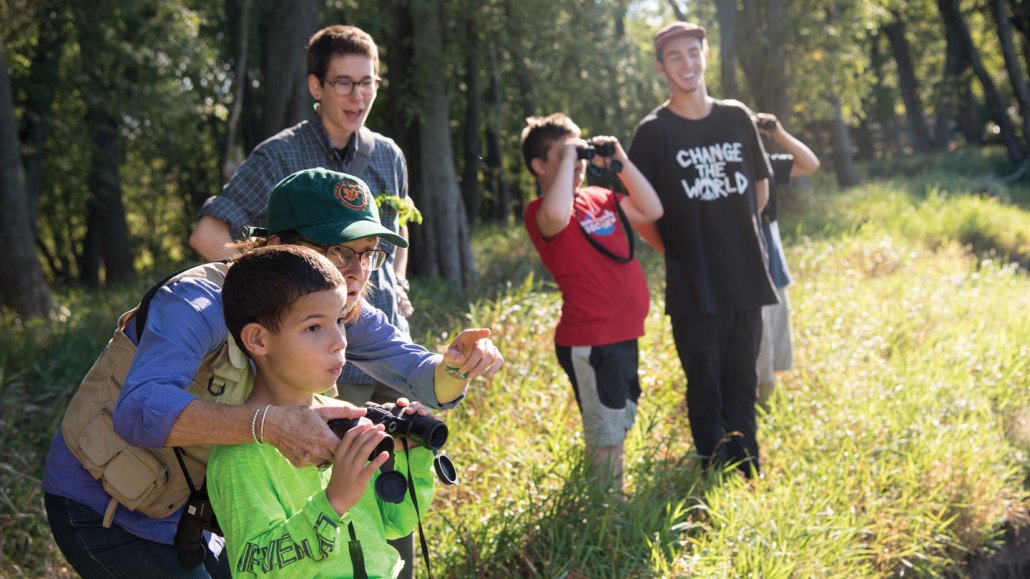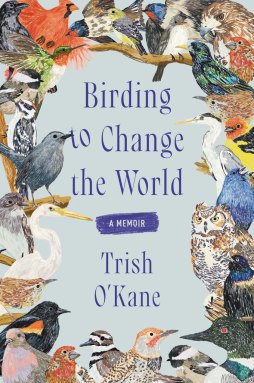A new book explores the transformative power of bird-watching
Trish O’Kane’s Birding to Change the World shows how birds and humans can help one another heal

Environmentalist Trish O’Kane (far left), a lecturer at the University of Vermont, takes students birding on Derway Island in Burlington.
Joshua Brown

Birding to Change the World
Trish O’Kane
Ecco, $29.99
A “spark bird” is the species that inspires someone to start bird-watching. For Trish O’Kane, that bird was the northern cardinal. The backyard regular caught her eye while she was living with a friend in New Orleans, five months after Hurricane Katrina ravaged the region and her house in August 2005. Hearing cardinals’ chipping calls was an initial step toward over 1,960 hours of birding, 33 field notebooks filled with avian antics and a career change.
In her memoir, Birding to Change the World, O’Kane charts her pivot from human rights journalist to environmentalist. She worked as a hate crime researcher, an investigative reporter and a writing instructor for incarcerated mothers before starting work as a journalism instructor at Loyola University New Orleans the week before Hurricane Katrina hit (SN: 8/23/15).
“How to stop war, how to end economic injustice, how to fight racism and white supremacy — these global problems were the focus of my life and work,” O’Kane writes. “I never paid any attention to environmental issues.”
Her fledgling interest in birds actually began a few days before the monster storm arrived. O’Kane notes how, despite the gorgeous weather, flocks of alarmed gulls shrieked over one of the levees near Lake Pontchartrain. “This was the first time I began to think of them as more than pretty flying objects and instead as creatures with their own agendas,” she writes. “But they can’t watch CNN, so how could they possibly know that a massive hurricane is going to hit us in less than forty-eight hours?”
It’s one of many moments where O’Kane makes sense of the bizarre abilities of birds — bizarre by human standards, anyway — by weaving established research with interviews with scientists (SN: 6/28/21). The gulls were reacting to sharp drops in barometric pressure from the encroaching storm.
Post-Katrina, O’Kane must navigate between working at Loyola and coping with the loss of her home. She finds relief in watching the birds that flit about in New Orleans’ Audubon Park. She starts bringing her class along for writing sessions. House sparrows, often scorned by bird enthusiasts for killing native birds, transform into a symbol of resourcefulness by building nests and foraging among the wreckage.
“My students stare at me in disbelief when I tell them that until I was forty-five years old, I never cared about birds,” O’Kane writes. She strived to make the world a better place for people. Now she was considering the welfare of wildlife. “I suddenly wondered how many creatures had died simply because of the way I lived.” She decides to pursue an eco-oriented career. In 2007, she enrolls in a doctorate program at the University of Wisconsin–Madison to study environmental science.
Most of the book focuses on O’Kane’s efforts to preserve Warner Park, along Madison’s Lake Mendota. It’s a convenient location for O’Kane to satisfy birding requirements for an ornithology class. But soon she successfully campaigns to stop the construction of a parking lot in one of the park’s meadows. Her activism snowballs into Wild Warner, a local crew of wildlife watchers flocking together to defend the park from further development. The organization eventually becomes part of O’Kane’s dissertation research, along with a birding class that pairs middle school students with college-student mentors.
It’s here that the memoir shows readers that an expertise in nature doesn’t require a degree. Take Jan, a retired feed mill worker plagued by chronic obstructive pulmonary disease. O’Kane calls Jan an “ecology gold mine” of animal stories, thanks to his walks through Warner Park prescribed by his doctor. Then there’s Jeremy, a seemingly disinterested boy enrolled in O’Kane’s birding class. When reporters join an outing, the normally quiet Jeremy gushes about indigo buntings. O’Kane soon learns that Jeremy had taken to secretly studying the field guide gifted to him by his mentor.
O’Kane’s love for common birds fuels much of her work, a refreshing reminder of the incredible feats of nature happening in our own neighborhoods. A birder chasing the next exotic species to cross off their “bird life list” might dismiss the sighting of a shy gray catbird, readily found “meowling” under the cover of a nearby hedge. O’Kane, though, studies catbird migration. By strapping the birds with radar backpacks, her team confirms that the Warner Park’s catbirds migrate every fall as far as Mexico and Guatemala before returning each spring.
At its core, Birding to Change the World is about how people and birds today depend on one another. For birds, that dependence is tangible — for instance, the preservation of marsh habitat for wetland species. For people, the connection can be less concrete.
“For millennia, our species has seen birds as symbols of liberation,” O’Kane writes. In her case, it was liberation from the grief and depression that Katrina brought. “Bird by bird, every chickadee, nuthatch, catbird, wren, and owl forged a new neural pathway in my brain, a joyful pathway.”
Buy Birding to Change the World from Bookshop.org. Science News is a Bookshop.org affiliate and will earn a commission on purchases made from links in this article.






